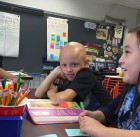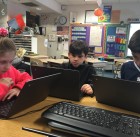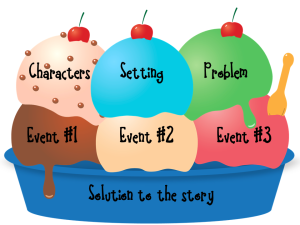Viewing: short answer response
October 4, 2015

Learning to Collaborate
A big focus in Room 209 in learning to collaborate on tasks and explain your thinking. People often think that collaboration helps during challenging activities, and that’s certainly true. But we also have students collaborate even when they could easily complete a task independently, because the process of sharing ideas, considering other points of view, and discussing strategies and options helps students to think more deeply about a given topic. It also helps to develop collaboration skills that are, of course, critical life skills.
Last week, for example, we began working on narrative elements by focusing on the setting of stories. We read, as a class, The Purple Coat (one of my all-time favorites) and identified clues about the setting. I then modeled the process of writing a short-answer response (SAR) to identify and explain the setting of the story. We looked at the SAR Checklist as a way of remembering the elements of a successful short-answer response. Students then collaborated with one or two partners to write a similar response about The Josefina Story Quilt, which students read for homework on Monday or Tuesday. We shared some of these responses (from groups that volunteered) and discussed strengths and weaknesses, using the new fourth grade SAR rubric. (Stay tuned for some resources for parents!) On Friday, students worked independently to write their own SAR about the setting of A Chair for My Mother (which is arguably my all-time favorite children’s book). This process of gradual release supports students as we move from teacher-led learning to group work to independent application. You’ll see a lot of this style of learning this year, especially in the next few weeks as we address the remaining narrative elements.
Posted in Class Updates|By Jon Moss
January 20, 2015

Respect for all races, religions, and cultures
This is my favorite time of the school year, not because of the beautiful weather (yuck) but because of the terrific units we are starting in class. Our class recently read a book called As Good As Anybody, which tells the stories of Martin Luther King, Jr. and Abraham Joshua Heschel – two men who had very different lives but experienced very similar adversities, and who ended up working together to make our world a better place. We always start this a week or two before Martin Luther King, Jr. Day, and it gives us a terrific opportunity to explore the wonderful contributions that Dr. King made to our society. As a class, students identified ways in which the two gentlemen were similar and different, and they used that comparison document to write short answer responses (in small groups) comparing and contrasting the men. This gave students the background so that they could write their own responses to a similar story, The Other Side, independently.
All the kids were familiar with Martin Luther King, Jr, but none of them knew who Abraham Joshua Heschel was. (At that age, I didn’t either.) He grew up in Europe and was a persecuted Jew during the beginning of the Holocaust. He fled to the United States and, along with Dr. King, he worked to promote a world in which everyone was treated with respect and dignity. Although the kids don’t yet know this, our study of As Good As Anybody launched our study of the Holocaust, which will really kick-off next week, as we begin work with the outstanding novel Number the Stars. In the coming days and weeks, you’ll hear much more from me about this unit. Some parents understandably are concerned about their children being taught things that are frightening or upsetting. Rather than focusing on the disturbing events that took place during this infamous time in history, we instead focus on the feelings and attitudes of people – the persecuted Jews, those who secretly supported the Jews at their own risk, those who did the persecuting, etc. We steer clear of the graphic details. As I said, stay tuned for more information coming your way soon.
Have a great week!
Posted in Class Updates|By Jon Moss
December 22, 2014
Narrative Elements, Connections to Text
Well hello! It’s been some time since I’ve posted an update here, so please accept my apologies. A side effect of having easy access to the Chromebook laptops and the student Gmail accounts is the reality that I tend to do more of my communication with students through those means (such as emailing assignments and information), rather than posting messages here. A reminder: Parents should ALWAYS have the ability to log-in to their children’s APS gmail accounts. If you need the username or password for your child, please let me know.
 In recent weeks, we finished our first major reading unit, which focused on identifying and explaining the narrative elements in a text. These elements, which we sometimes described as being ingredients making up an ice cream sundae, represent the different parts of a narrative story. While we did work in class on identifying these elements, I found (as I normally do) that this was a pretty straight-forward task for the students. Instead, we focused more on supporting their responses with well-selected evidence from the text. For example, if we wanted to describe the wolf in Little Red Riding Hood as being “sneaky,” we’d look to the text to find evidence that supports the opinion that the wolf is, in fact, sneaky. This is a year-long focus, as kids need to support their responses with evidence in any number of situations, ranging from narrative elements to connections to predictions. In fact, you may often see the same requests made on many math homework worksheets, on which kids need to support their reasons why they agree or disagree with an answer or how they solved a given math problem. When your fourth grader brought home his or her literacy binder recently, you hopefully had the opportunity to review the character traits response to The Josefina Story Quilt, in which students planned their responses on a graphic organizer, wrote a draft response, and later revised their work based on my written feedback and an in-class review of how to craft a well-supported short-answer response.
In recent weeks, we finished our first major reading unit, which focused on identifying and explaining the narrative elements in a text. These elements, which we sometimes described as being ingredients making up an ice cream sundae, represent the different parts of a narrative story. While we did work in class on identifying these elements, I found (as I normally do) that this was a pretty straight-forward task for the students. Instead, we focused more on supporting their responses with well-selected evidence from the text. For example, if we wanted to describe the wolf in Little Red Riding Hood as being “sneaky,” we’d look to the text to find evidence that supports the opinion that the wolf is, in fact, sneaky. This is a year-long focus, as kids need to support their responses with evidence in any number of situations, ranging from narrative elements to connections to predictions. In fact, you may often see the same requests made on many math homework worksheets, on which kids need to support their reasons why they agree or disagree with an answer or how they solved a given math problem. When your fourth grader brought home his or her literacy binder recently, you hopefully had the opportunity to review the character traits response to The Josefina Story Quilt, in which students planned their responses on a graphic organizer, wrote a draft response, and later revised their work based on my written feedback and an in-class review of how to craft a well-supported short-answer response.
We’re now starting to focus on making connections to text. In class, we read a story called One Green Apple (a terrific story, if you’re not familiar with it), and you may remember a recent homework assignment in which students had to write about different connections they made to the text. In class, we looked at the difference between a coincidental connection (I, too, have been to an apple orchard!) vs a deeper, more meaningful connection (I, too, have felt out of place when everyone around me spoke a different language than the one I spoke.) Right now, we’re focusing on making connections to feelings.
Our work with One Green Apple will also kick off our author study of Eve Bunting, who has written so many wonderful texts about a variety of meaningful topics. Her books often have many things to which kids can relate, while also introducing new concepts that are unfamiliar to many fourth graders. She’s a top-notch author!
Once again, thank you for your patience in waiting for an update, and I’ll try to post more regularly in the new year.
Posted in Class Updates|By Jon Moss
February 26, 2014

Working to Improve Reading Responses (Part 1)
Note from Jon: This is the first of (probably) three posts that address reading comprehension and critical response skills. This particular post is an updated version of a message I wrote three years ago on our class website. I know it’s long, but you might find it helpful!
One of the primary focuses of reading instruction is helping students to improve the quality of their short answer responses. Unlike multiple choice, true false, or fill-in-the-blank items in which there is a clear right answer, SAR tasks create situations in which students’ success hinges on the quality of their responses, not just their accuracy. I tend to find that there are three rules that often help students to be more successful when writing their own short answer responses:
- Always show the reader that you read and understood the story or article. PROVE IT!
- Always include some sort of textual support to explain your answer.
- Read the WHOLE question! Answer the WHOLE question!
Can you tell what the big trouble spots are? All three rules include the idea of needing to fully address the question by including relevant story details. Frequently, students lack the necessary supportive evidence from the text to reinforce their answer. As I often remind the students, any SAR question faced during reading has one main goal: To determine if the student understood and can interpret what he or she has read. If the student’s response lacks specific detail from the text, the reader has no way of measuring the student’s understanding. Take, for example, the following question and answer:
Question: What two questions would you ask the author of this article?
Answer: I would ask her why she chose to write about insects and what kind of insect is her favorite.
At face value, this response looks like it successfully answers the question – and in all fairness, it does. But while the question does not explicitly require students to integrate information from the article, this (fictional) student’s failure to do just that leaves us with a weak answer that does not show any understanding of the story. Both of the questions that the student suggested in his or her response show only a cursory understanding of the text: the story is about insects. There is no evidence of any in-depth understanding. This alternate response shows more in-depth comprehension by including details from the (pretend) article:
There are two questions that I would ask the author. First, I would ask her “Why are centipedes called centipedes if they can actually have between 20 and 300 legs?” Centi means “hundred,” so I would expect a centipede to have 100 legs. I would also ask “Are insects with exoskeletons larger than those with skeletons inside their bodies?” I’ve never seen a large insect before.
Notice a few particular strengths with this response. First, the student clearly wrote two questions – ending in question marks. (Yup, that matters!) Second, the student’s suggested questions include appropriately used terminology from the text (centipedes, exoskeletons) and concepts from the text (20-300 legs, meaning of centi, exoskeletons are outside the body). By including relevant details from the text, the student has shown that he or she is able to read and understand the text and that they can evaluate information in order to use the most relevant details as supportive evidence. This is a strong response.
This type of activity is hardly new. Students have been going “full-steam” on short answer responses since the start of third grade, if not earlier. Our expectations for short answer responses don’t change much from year to year, minimizing the “moving target” problem for kids. So why do some students continue to struggle? I see three possible causes:
- Some students are having a genuinely hard time. This describes the student who sees the question, thinks about what the best possible response could be, but for any number of reasons, he or she is not crafting successful responses. The student may not be struggling with the skill, per se, but he or she may simply have yet to master the grade-level expectations that go with the skill of writing a short answer response. I’m continuing to work with students on an ongoing basis to help them to strengthen their skills.
- Sadly, some students are unsuccessful because they simply did not carefully read the question being asked of them. Consider the two part question: “Do you agree with Laura’s decision at the end of the story? What advice would you give her so she could solve her problem without hurting Lester’s feelings?” A student could write an outstanding response about why they do or do not agree with Laura’s decision, citing lots of support from the text. But without addressing the second part of the question, the response falls short, and so will the score. Unfortunately, it’s not uncommon for responses to be more off-base than the example I’ve cited in this paragraph. Sometimes kids write an answer that may be well-crafted and thorough, but it may also be entirely irrelevant to the question asked, and again, points cannot be given.
- The most disappointing cause of difficulty is when students simply do not appear to be working with their best effort and focus. This is not a lack of understanding or mastery. Rather, in this situation, students may quickly write a cursory response that lacks detail or support because they chose not to work to their potential because, perhaps, they hurried through their work. These responses do not show a thorough understanding of the text, even though the student may truly have a high degree of comprehension. Convincing students of the need to put more thought and effort into their work is very challenging, because it’s a decision they need to make for themselves. No amount of prodding from you or from me will make it happen. Rather, they need to choose (hopefully with our help) that it’s time to bring their proverbial “A-game” to class. I’m bringing this up to you en masse for two reasons: First, I think that all students can benefit from a reminder about the importance of doing their best possible work. All of us, every now and then, fall short of this, so some helpful encouragement is valuable. Second, in some cases, I see this as a behavioral issue – if a student is choosing not to put in their best effort, despite having been reminded of the importance of doing so, they are not following directions and are not showing responsibility. That’s something I hope we can tackle together.
At the end of this week, your fourth grader will bring home his or her literacy binder for your to review over the weekend. In it, you will find several new work samples, many of which are short answer responses. As you review your child’s responses, look at their use of evidence and see how it influenced their score. (As a reminder, short answer responses are scored out of four possible points, with a goal of three points.) Conferences are coming up in a few weeks, and I look forward to talking with you more about this.
In my next post, I’ll share some strategies for how students can carefully select the most helpful textual evidence to support their responses.
Posted in Class Updates, Learning Resources, Reading|By Jon Moss
